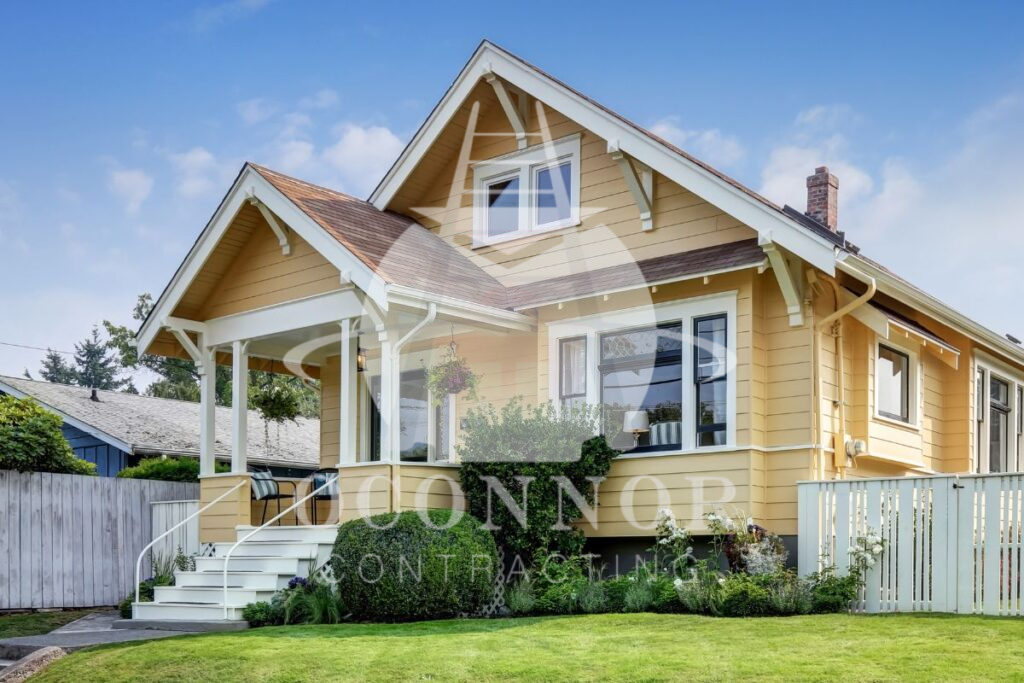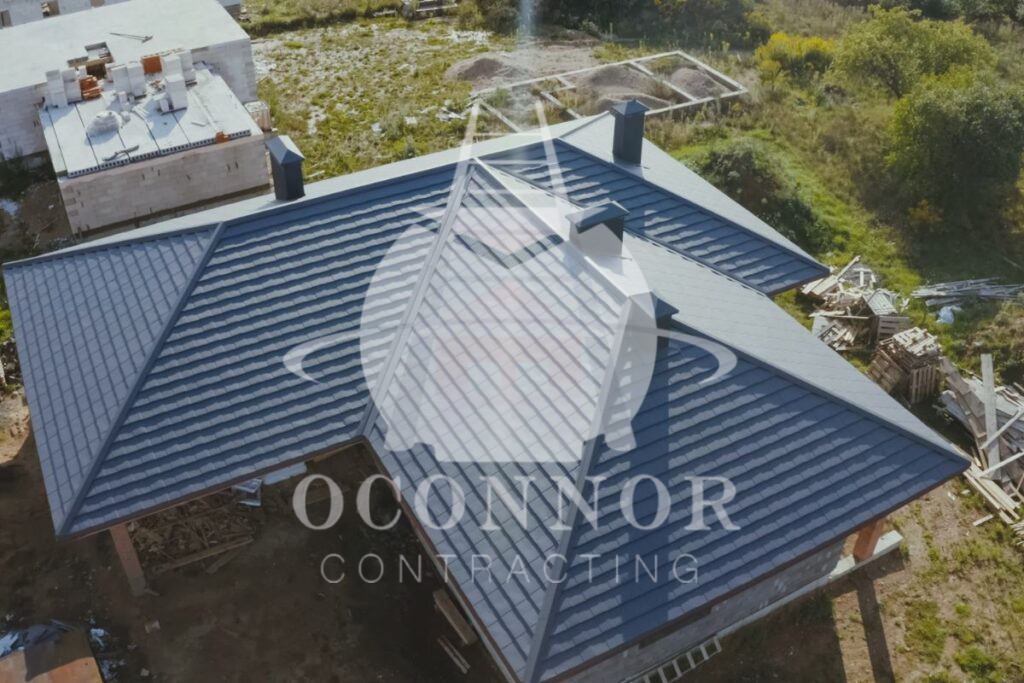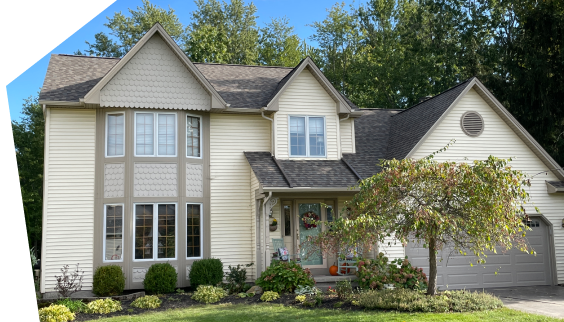The roof over your head is more than just a shield, it’s a style statement too! So whether you’re building your dream home or sprucing up your current one, the roof you pick is a big deal. Gable and hip roofs are two really popular options that a lot of homeowners go for, but which one’s right for you?
In this blog post, let’s break down the good and the not-so-good about gable roofs vs. hip roofs, so you can choose the one that suits your needs and style perfectly.
What Is A Gable Roof?

A triangular roof with two sloping sides meeting at a central ridge is called a gable roof. The simplicity and symmetry appearance of this timeless design makes it appealing. There are other variations of gable roofs, such as front gables, where the ridge is perpendicular to the front, side gables, and cross gables, where several gables overlap at different angles.
The ageless charm, ease of building, and affordability of this type of roof have made it a staple of American architecture for decades. Gable roofs also improve functionality and appearance by providing ample ventilation and the ability to add windows or dormers.
| PROS | CONS |
| Simple Build: Easy to design and build, leading to quicker installation. | Wind Damage-Prone: Can catch wind, risking damage in severe weather. |
| Strong Drainage: Slope helps water and snow drain off, reducing leaks. | More Frequent Repairs: May need more maintenance due to wind and weather damage. |
| Affordable Option: Typically costs less because of fewer materials and less labor. | Structural Considerations: Needs proper support to prevent collapse, especially under heavy snow. |
| Increased Ventilation: Design improves airflow and attic ventilation. |
What Is A Hip Roof?

Similarly, a hip roof, with its sloped sides converging at the top, is a popular and stable roofing style with four sloping sides, unlike gable roofs with only two. This design creates a more robust structure that handles weather conditions well and offers better wind resistance, making it ideal for windy areas.
Hip roofs come in various styles, from simple to complex, and often include elements like dormers for added aesthetics and functionality. The slope can vary, with ratios like 6:12, indicating a rise of 6 inches for every 12 inches of horizontal run. This design provides effective drainage and maximizes attic space, making it a practical choice for residential buildings.
| PROS | CONS |
| Attractive Design: Hip roofs look sleek from all angles, enhancing curb appeal. | Higher Costs: Their complex design makes them more expensive to build. |
| Sturdy Structure: Inward slopes add stability and resist wind damage. | Leak Risks: More seams increase the risk of leaks if not well-maintained. |
| Wind Resistance: The sloped design helps divert wind, ideal for windy areas. | Reduced Attic Space: Less attic space compared to gable roofs. |
| Good Drainage: Angles help rain and snow drain off easily, reducing water issues. | Regular Maintenance: Requires frequent checks for leaks and seam integrity. |
| Stable Gutters: Slopes support an effective gutter system for heavy rains. | Complex Installation: Needs skilled labor for installation, increasing cost and complexity. |
Comparative Analysis: Hip vs. Gable Roof
#1. Design Structure
A gable roof features two sloping sides that meet at a peak, forming a triangle shape. This design often includes vertical walls at the ends, allowing for windows and ventilation. In contrast, a hip roof has slopes on all four sides that converge at a ridge, creating a smooth, symmetrical appearance without vertical walls above the eaves.
#2. Durability and Weather Resistance
While effective at shedding rain and snow, gable roofs can be less sturdy in high winds, with the potential for uplift if not reinforced. Conversely, hip roofs are generally stronger and better at handling severe weather conditions, such as strong winds and heavy snow, thanks to their self-bracing structure.
#3. Ventilation and Energy Efficiency
Ventilation is a strong point for gable roofs, as their vertical sections allow for easy installation of vents or windows, improving airflow and energy efficiency. Although hip roofs offer fewer options for vents and windows, careful planning can still ensure good airflow and maintain energy efficiency.
#4. Aesthetic Appeal
Both gable and hip roofs have unique aesthetic qualities that affect a home’s overall look. Gable roofs offer a classic, symmetrical design with timeless charm, especially for traditional styles. Hip roofs, on the other hand, present a modern, sophisticated appearance that suits contemporary designs. Choosing between them depends on personal taste, the home’s style, the desired curb appeal, and resale value.
#5. Noise Insulation
Noise can be more of an issue with gable roofs if they aren’t well-insulated, as their vertical walls may let sound travel easily. In contrast, hip roofs generally offer better noise insulation. Their sloped design helps deflect sound waves, and with proper insulation, they create a quieter indoor environment, making them a better choice for noisy areas.
#6. Maintenance and Repairs
Since their vertical sections are easily accessible, gable roofs are often easier to maintain and repair. This is because problems like leaks or damaged shingles are easier to find and address. Hip roofs are typically harder to access and have several ridges and slopes. This intricacy can make repairs more difficult and expensive, frequently necessitating specialized knowledge.
Practical Considerations for Homeowners
#1. Cost and Construction
Gable roofs are usually more affordable due to their simple design, which requires fewer materials and less labor, resulting in faster installation. Similarly, hip roofs are more expensive because of their complex design, which demands extra materials and labor. Despite the higher cost, hip roofs’ increased durability and attractive look can make them a worthwhile investment.
#2. Space and Storage
Since gable roofs are triangular in design, they can have taller ceilings, which are useful for storage or, if permitted by building rules, can be converted into living space, giving more usable attic space overall. Hip roofs, on the other hand, have sloping designs on all four sides, which reduces the amount of vertical space in the attic and may limit storage and conversion possibilities.
#3. Climate Considerations
The local climate affects roof choice. Gable roofs handle heavy snow well because their steep slopes help snow slide off, reducing collapse risk. Hip roofs are better for high winds and heavy rain, making them suitable for stormy or coastal areas. Choose a roof based on local weather to ensure safety and effectiveness.
#4. Insurance and Financial Implications
Roof type affects insurance, costs, and resale value. Gable roofs may cost more to insure in windy areas due to their vulnerability to wind damage, while hip roofs are more stable and can lower premiums. Hip roofs cost more to install but offer durability and higher resale value, whereas gable roofs are cheaper initially but may incur higher repair costs over time. Hip roofs appeal more to buyers seeking modern designs, while gable roofs might be less attractive in contemporary markets.
Final Verdict: Gable Roof vs. Hip Roof
Choosing between a gable or hip roof depends on climate, budget, and home style. Hip roofs offer structural stability and weather resistance, while gable roofs may suit specific needs or designs.
Conclusion
There is no one-size-fits-all answer when choosing between a gable or hip roof. Each style has pros and cons, so it’s best to consult a professional roofing contractor who can assess your needs and guide you in selecting the best roof style for your home.
Want reliable roofing services in Buffalo? Trust OConnor Contracting! Whether you need a repair, replacement, or new installation, our skilled team ensures quality work and customer satisfaction. Contact us today at (716) 600-7663 for an instant quote.


